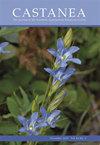The Effects of Varying Nutrient Availability on Females and Hermaphrodites of the Gynodioecious Geranium maculatum
IF 0.3
4区 生物学
Q4 PLANT SCIENCES
引用次数: 0
Abstract
ABSTRACT Sexual dimorphism in plant growth and/or reproductive responses to the surrounding environment has been documented in some plant species. In gynodioecious plants, it is especially important to understand whether females and hermaphrodites differ in their response to environmental stressors, as the fitness of females relative to hermaphrodites determines the extent to which these separate sexes are maintained in natural populations. Soil nutrient availability is of particular importance given the different nutrient requirements of male and female sexual functions in plants. Here, we evaluated and compared the growth of females and hermaphrodites of Geranium maculatum in response to varying levels of nutrients. Using a greenhouse experiment, we manipulated the overall nutrient, nitrogen, and phosphorus levels in the soil and measured growth, allocation, and leaf quality responses in both females and hermaphrodites. We found that the sexes responded similarly in their growth and allocation responses to nutrient availability, despite evidence that female leaf chlorophyll content may have increased more than that of hermaphrodites across soil nitrogen levels. Our findings demonstrate that while hermaphrodites may differ from females in terms of their physiological response to varying nutrient levels, these slight physiological differences do not translate into meaningful growth differences.不同养分有效性对黄老鹳雌、雌生殖能力的影响
在一些植物物种中,植物生长和/或生殖对周围环境的反应存在两性二态现象。在雌蕊异株植物中,了解雌性和雌雄同体对环境压力的反应是否不同是特别重要的,因为雌性相对于雌雄同体的适应性决定了这些不同性别在自然种群中维持的程度。考虑到植物雄性和雌性性功能对养分的不同需求,土壤养分有效性尤为重要。在这里,我们评估和比较了雌性和雌雄同体黄斑天竺葵对不同营养水平的反应。通过温室试验,我们控制了土壤中养分、氮和磷的总体水平,并测量了雌性和雌雄同体的生长、分配和叶片质量的响应。我们发现,尽管有证据表明,在不同土壤氮水平下,雌性叶片叶绿素含量可能比雌雄同体叶片叶绿素含量增加得更多,但两性对养分有效性的生长和分配反应是相似的。我们的研究结果表明,虽然雌雄同体在对不同营养水平的生理反应方面可能与雌性不同,但这些轻微的生理差异并不转化为有意义的生长差异。
本文章由计算机程序翻译,如有差异,请以英文原文为准。
求助全文
约1分钟内获得全文
求助全文
来源期刊

Castanea
生物-植物科学
CiteScore
0.50
自引率
25.00%
发文量
28
审稿时长
>12 weeks
期刊介绍:
Castanea is named in honor of the American Chestnut tree. Castanea is thebotanical name for Chestnuts, dating back to what the ancient Greeks calledthem.
The American Chestnut is a critically endangered tree that once made up 35%of the forests of the Eastern US before being devastated by a blight thatdestroyed up to 4 billion American Chestnut trees.
Castanea serves professional and amateur botanists by reviewing andpublishing scientific papers related to botany in the Eastern United States.
We accept papers relating to plant biology, biochemistry, ecology, floristics,physiology and systematics.
 求助内容:
求助内容: 应助结果提醒方式:
应助结果提醒方式:


